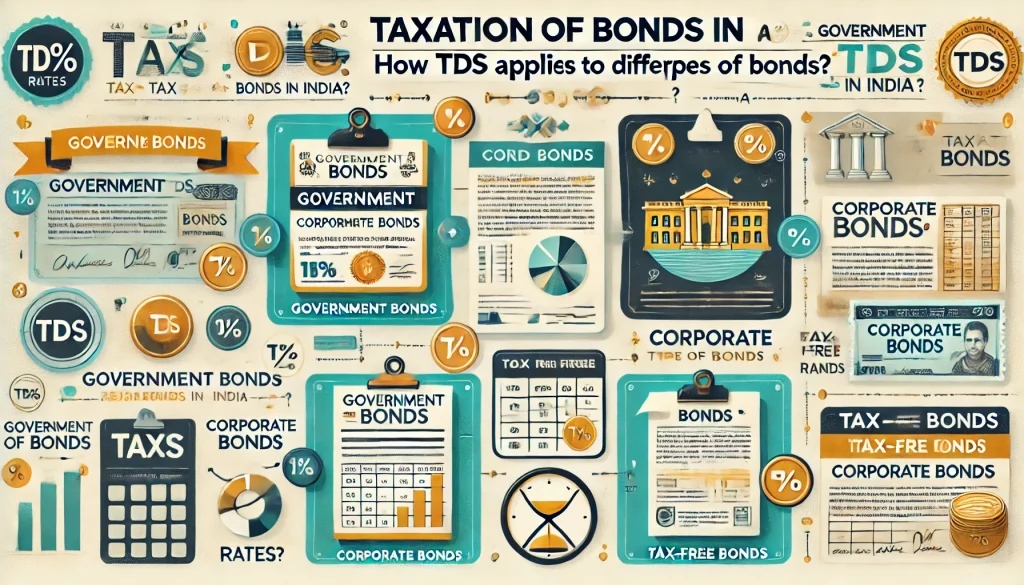
Bonds are debt instruments used by public as well as private entities to raise funds for a purpose. In return, such entities offer investors guaranteed returns as well as repayment of the principal amount within a stipulated time.
Depending on the type of issuer, bonds can be govt. bonds, municipal bonds, public sector bonds, and corporate bonds. In this blog, the focus will solely be on Government Bonds, their types, interest rates, investment procedures, and other details.
What are Government Bonds?
Government bonds are issued by both Central and State governments in times of liquidity crisis or requirements for a specific purpose. A govt bond falls under the umbrella of government securities (G-Sec). These bonds are usually long-term investments with tenure ranging between 5 and 40 years.
In the beginning, most Indian Government bonds were available to established investors such as commercial banks. Eventually, they have been made available to smaller investors such as cooperative banks, individual investors, etc.
The interest rates of government bonds are known as coupons. These coupons can either be fixed or floating and are disbursed on a half-yearly basis. Generally, a government bond is issued at a fixed rate of interest.
Types of Government Bonds in India
There are different types of Indian Government bonds available based on their issuers, tenure, and rates of interest. These bonds can be good investment options for portfolio diversification, offering stability and a regular source of income.
Get familiar with the types of bonds before you start investing.
1. Sovereign Gold Bonds (SGBs)
Sovereign gold bonds or SGBs are a type of dated government securities that are issued in denominations of grams of gold. You can invest in them through stock exchanges, banks, and post offices. An SGB comes with a competitive interest rate of 2.50%, payable semi-annually.
The biggest advantage of SGB is that it does not require storage, reducing the risk of security. Moreover, you can benefit from capital appreciation and interest income since government bonds are linked to gold’s market price which tends to appreciate over time.
2. Floating Rate Bonds (FRBs)
Floating rate bonds, another type of dated government securities, have coupon rates that are linked to a benchmark rate. Hence, it keeps fluctuating over a bond’s duration and delivers benefits during higher rates of interest. However, there is no certainty when it comes to earning income from such bonds due to the fluctuations.
3. Fixed-Rate Bonds
The nature of fixed-rate bonds is just the opposite of Floating Rate Bonds. These bonds offer a certain source of income and are hence preferred by traditional or risk-averse investors. As the name suggests, their interest rate remains fixed throughout the tenure. Upon maturity, investors receive the principal and interest amount on a yearly or half-yearly basis.
4. Inflation-Indexed Bonds
This type of government bonds safeguard investors from inflation by aligning the coupon rate with that of inflation. Unlike the other types of government bonds, the principal amount of inflation-indexed bonds fluctuates by the current inflation rate. Hence, both the principal amount and interest earned at maturity are impacted by inflation to maintain the face value of the bond.
5. Treasury Bills
Treasury bills usually have three categories of maturity periods – 91, 182, and 364 days. The striking difference between a treasury bill and other types of government bonds is that it does not come with a coupon rate. Instead, investors get to buy them at a discounted face value. The income will be the difference between the discounted and face value at the time of redemption.
To illustrate, suppose, you have purchased a treasury bill worth ₹200 at a discounted price of ₹158. Hence, your gain at the time of redemption will be ₹(200 – 158) = ₹42.
Another fact you must know is that the RBI puts up auctions of 91-day treasury bills every Friday and 182-day and 364-day treasury bills every second Wednesday.
6. State Development Loans (SDLs)
State development Loans have a fixed maturity date and pay interest at an interval of 6 months. The face value is redeemable at maturity. These are facilitated by RBI through the Negotiated Dealing System.
7. Government Securities (G-Sec Bonds)
Government securities bonds are designed with a long investment tenure ranging between 91 days to 40 years. These debt instruments are issued by the Government of India through auctions arranged by RBI. G-Secs are considered to be one of the safest investment options since the government guarantees the repayment of principal at maturity.
8. Government of India Savings Bonds
GoI Savings Bonds are retail bonds, issued by Govt. of India through designated banks. These are secure investment choices with fixed coupon rates, offering a wide range of tenures.
9. 7.75% GOI Savings Bond
7.75% GoI Savings Bonds offer a fixed coupon rate of 7.75% p.a. and interest pay-out happens at an interval of 6 months. It comes with a redemption period of 7 years. The bond offers comparatively high and stable interest rates when compared to fixed-income securities.
10. Zero-Coupon Bonds
Zero-coupon bonds, as the name suggests, do not offer regular interest payouts. Instead, the interest gets accumulated over time and is paid at maturity along with the principal. These bonds are issued at a discounted price and are ideal for investors who want a lump sum payment at a later date and do not require regular income through their investment.
Government Bonds Interest Rate
The table below includes 10 government bonds interest rates and other necessary details. The table is in descending order as per the bonds’ yields.
| Bond | Yield | Tenure | Price (in ₹) | Coupon Rate | Minimum Investment Amount (in ₹) |
| 6.72% Haryana SDL 2035 | 7.7600% | 11y 11m 27d | 93.0400 | 6.72% | 10,00,000.00 |
| 8.49% Rajasthan SDL SPL 2026 | 7.7600% | 2y 11m 17d | 102.5300 | 8.49% | 10,00,000.00 |
| 8.53% RAJASTHAN SDL 2028 | 7.6300% | 4y 9m 29d | 104.1200 | 8.53% | 10,00,000.00 |
| 8.42% Assam SDL 2028 | 7.6300% | 4y 9m 8d | 103.6500 | 8.42% | 10,00,000.00 |
| 8.22% Punjab UDAY 2026 | 7.6300% | 2y 4m 27d | 101.5800 | 8.22% | 10,00,000.00 |
| 7.30% Government Of India 2053 | 7.6300% | 29y 7m 19d | 97.7800 | 7.30% | 10,00,000.00 |
| 6.99% Government Securities 2051 | 7.6200% | 28y 1m 14d | 94.2500 | 6.99% | 10,00,000.00 |
| 8.05% Tamilnadu SDL 2028 | 7.6200% | 4y 5m 18d | 102.1100 | 8.05% | 10,00,000.00 |
| 8.57% RJ SDL SPL 2027 | 7.6200% | 3y 11m 17d | 103.6800 | 8.57% | 1,00,000.00 |
| 8.35% West Bengal SDL 2031 | 7.6100% | 5y 3m 20d | 103.7800 | 8.35% | 1,00,000.00 |
*Data valid as of October 27, 2023
How to Buy Government Bonds?
There are four ways through which you can invest in government bonds and securities. Let’s find out how.
Through Mutual Funds
- Step 1: Choose a gilt fund that invests in government bonds.
- Step 2: Submit the necessary documents to the AMC to go through the KYC procedure.
- Step 3: Visit the AMC’s website or contact a financial advisor to start investing through SIP or lump sum.
Investing through mutual funds is the simplest way of investing in government bonds and securities. You can consult with a financial advisor if you find the procedure complicated or have doubts before investing.
Through Direct Platforms
There are two different direct platforms through which you can invest in government bonds:
- RBI Retail Direct Portal: RBI has introduced the RBI Retail Direct Portal for regular investors to invest in different bonds. You need to register yourself in the portal and you can start investing in treasury bills and other G-Secs.
- Designated Banks: Another direct platform of investing is a designated bank or a dealer who has the permit to deal in government bonds and securities. They often facilitate such investments at either IPO or secondary markets.
Through a Registered Stock Broker
Investing through a registered stockbroker involves the following steps:
- Step 1: Open a trading and a demat account through a registered stock broker, if you do not already have either or both of them.
- Step 2: Submit the necessary documents such as PAN ID, address proof, etc. to complete KYC verification.
- Step 3: Research the various government bonds available, and check their maturity periods, coupon rates, and other details to choose the one that aligns with your investment goals.
- Step 4: Consult with your broker and ask for their advice and details.
- Step 5: Log in to your trading account and navigate to the section on government securities and bonds.
- Step 6: Choose the bond/s you wish to invest in and place your order mentioning the number of units you want to buy.
The bonds will be credited to your demat account once your order is processed. You will receive periodic interest payments in your linked bank account throughout the tenure and the principal will be transferred to the same account upon maturity of the bonds.
Through FAR
If you are a foreign investor (NRI and non-NRI) you can invest in these bonds and securities through FAR (Fully Accessible Route).
Advantages of Investing in Government Bonds in India
Knowing the advantages of investing in government bonds in India will help you make a more confident decision. Here are some of the advantages that you need to know.
- Sovereignty: Government bonds and securities come with a premium status of sovereignty. These are secure and stable investment options that guarantee returns. Being government offerings, these bonds and securities are liable to pay as per the stipulated terms.
- Hedge Against Inflation: Inflation-indexed bonds adjust the payable principal as well as the interest accrued as per the inflation rate. Moreover, capital-indexed bonds adjust the principal according to the inflation index to prevent capital value depreciation. Hence, investors dealing with these bonds receive increased face value at redemption due to an increase in the inflation index.
- Portfolio Diversification: Adding government bonds and securities to your portfolio could help in mitigating the risk of the overall portfolio. These debt instruments have a lower risk-to-return ratio as compared to equities and other assets. Hence, by including them in your portfolio you can add a cushion against market volatility.
- Regular and Stable Income Source: Most government securities pay interest at regular intervals which is usually 6 months. Hence, this can be a stable and good source of income if you are looking for one through your investments. If you do not have a stable source of income or want to plan retirement, these will make excellent choices.
Disadvantages of Investing Government Bonds
Along with the advantages, you should also be aware of the drawbacks that government bonds bring to make an informed investment decision. Take a look at some of its common drawbacks.
- Comparatively Low Returns: Government bonds and securities offer comparatively low interest earnings when compared to other investment options such as equity or corporate bonds. The only exception is the 7.75% GOI Savings Bond.
- Risk of Interest Rate: Government bond prices do not change proportionately to interest rates. The value of existing bonds decreases when the interest rates increase. This can lead to capital loss for investors who want to sell off their bonds before maturity. This risk is even higher for bonds with longer duration as the price fluctuation takes place over a longer period.
Risks Associated with Government Bonds
Although government securities and bonds are considered a safer investment option, there are various risks involved with such investments.
1. Credit Risk
Credit risk is the reason why you should check the bond’s credit rating before investing. Bonds with low credit ratings are at higher risk of defaulting and can make you lose all your investments.
2. Liquidity Risk
Government securities usually have high liquidity. However, bonds that are less actively traded or belong to niche markets may have liquidity risk. Selling such bonds before their maturity period can be challenging and affect the overall return on your investment.
3. Forex Risk
This risk is for the foreign investors. Currency exchange values can significantly impact your returns in the case of overseas investments.
4. Inflation Risk
Fixed-income instruments such as government bonds and securities are always at risk of getting affected by the purchasing power of money over time. The interest earned may not be at par with the rising inflation rate, resulting in a decreased ROI. However, by investing in capital-indexed and inflation-indexed bonds you can earn favourable returns.
5. Reinvestment Risk
Reinvestment risk arises when you choose to reinvest in your bond during a period of decreased interest rates. This can result in a significant loss in your return.
Who Should Invest in Government Bonds?
Investing in government bonds might be a favourable decision for the following individuals.
- Risk-averse investors.
- Investors that are seeking exposure for their portfolio as well as balance in its risk-to-return ratio.
- Individuals with long-term investment goals.
- Investors who are new to market-linked instruments and want to grasp the concept before moving to instruments with higher risk and return.
- Individuals looking to earn a regular and stable income from their investment.
Taxation on Government Bonds in India
Individuals investing in government bonds and securities or thinking of doing so must know the following tax implications.
- Interest accrued is subject to taxation as per the individual’s applicable tax slab.
- If the bond is held for over 3 years or longer, the return will be considered as LTCG and will be taxed at 20% post-indexation benefit.
- If the bond is held over for less than 3 years, the return will be considered as STCG and taxed as per your applicable tax slab.
- TDS applies to interest earned from these instruments at 10% for individuals and 20% for others. The only exception will be made if an individual provides Form 15G/15H stating their income is below the taxable limit.
- If the securities are unlisted, a 20% tax will apply to the gains.
Government bonds and securities are among the safer investment options when it comes to market-linked instruments. However, be sure to check their credit ratings to be on the safe side. Moreover, check their maturity period, coupon rate, and other details in order to make a suitable decision that aligns with your investment goals.
FAQs
Government bonds are usually not subject to taxation. However, you need to figure out your interest income to check whether you qualify for a tax exemption, in the case of a bond mutual fund or exchange-traded fund.
The composite interest rate is 6.89% for government bonds issued between November 2022 and April 2023.
Bond yield is the measurement of the return you can earn on that bond. It is determined by dividing the interest payment by the market price of bonds.
The yield on a 10-year government bond is 7.072% in India.
Yes, you can hold government bonds in the physical form of stock certificates. However, they are usually available in dematerialised format in your demat account.


